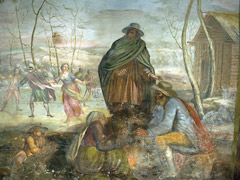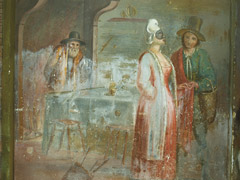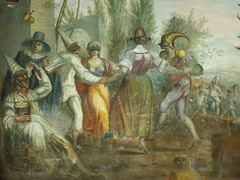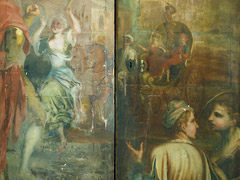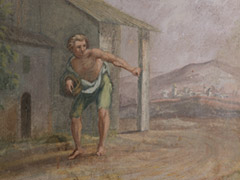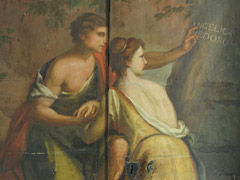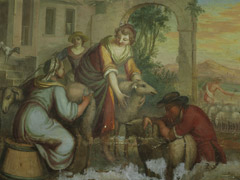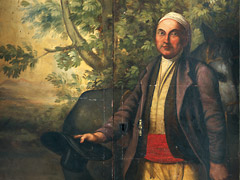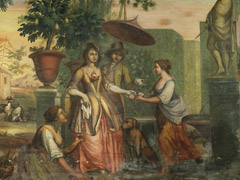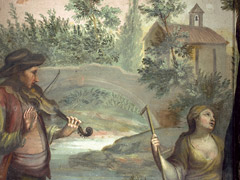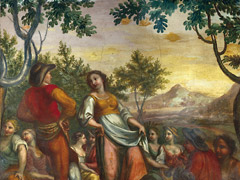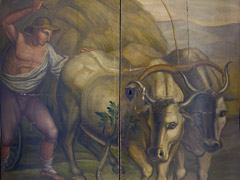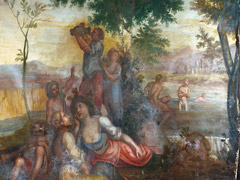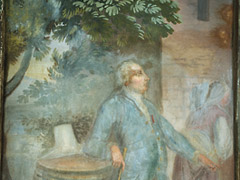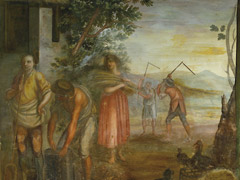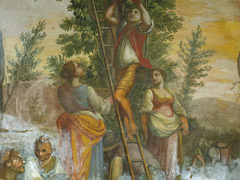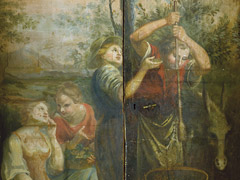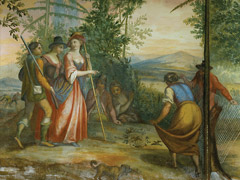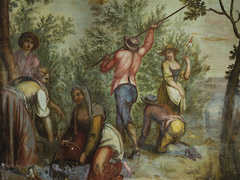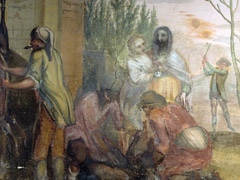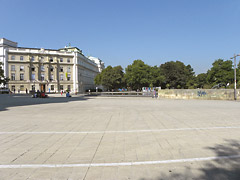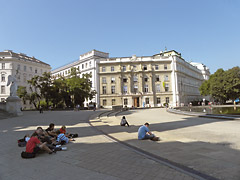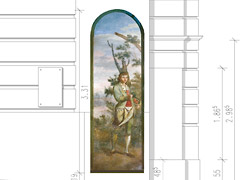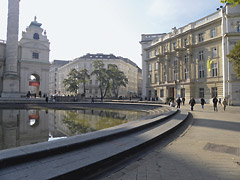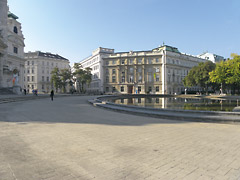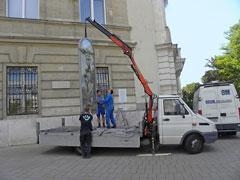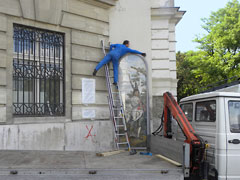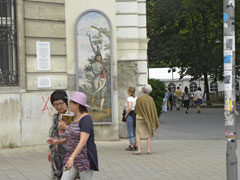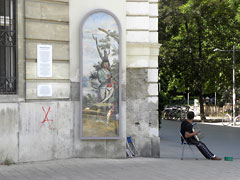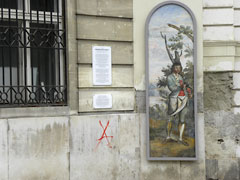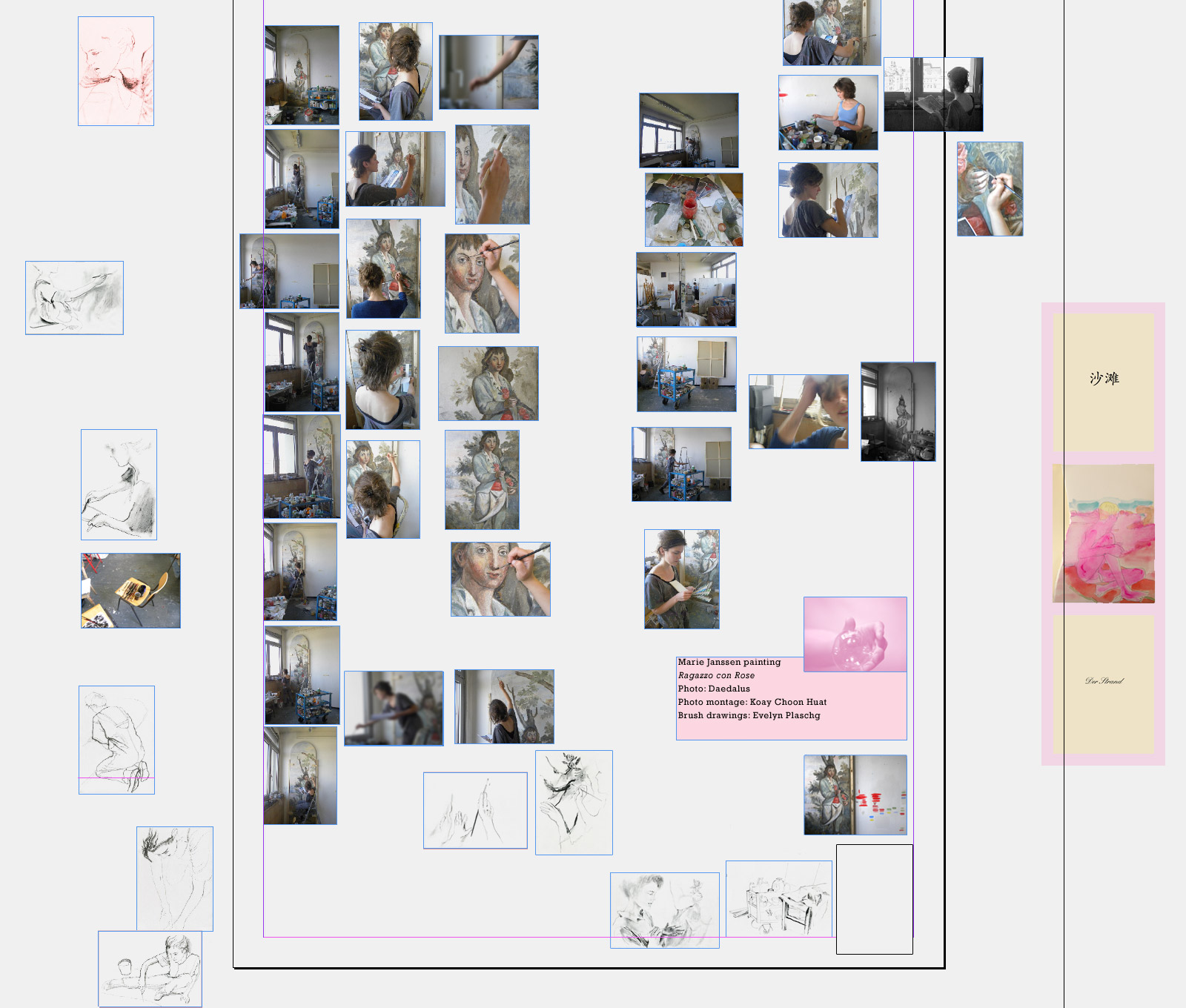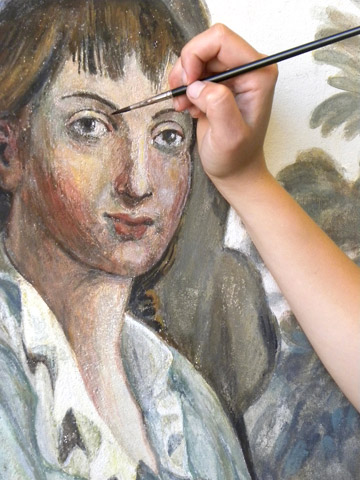
When the summer of 2012 has arrived, the painting of a gardener will appear on a narrow strip of wall on the building of the University of Technology in Karlsplatz square. It marks the exact geographical location of the cemetery known as »Spitaller Gottsacker«, which ceased to exist in 1783.
The casein painting is the copy of a mural which Ignazio Moder* produced at the Tuscan Villa di Geggiano in 1799. Ignazio Moder painted a gardener and roses with airy grace. »Lustgartner« (“pleasure gardener”) was the word used in the baroque age for those who planted and tended the ornamental gardens of stately homes.
The enraptured gaze of gardener and the physical properties of the roses in his garden are wonderfully dense moments in the mural.
Passers-by who happen to cross the square and see the mural will sense convergence with the secrets of a strangely disconnected world.
On the one hand, a glimpse of the hortus conclusus is a glimpse of Christian paradise, the opposite of hell – and heaven is often referred to as a rose garden – on the other hand, it is also a glance of the paradeisos of Antiquity, which originated in the ancient orient; in the world of Antiquity, it was a place slightly different from the Christian concept, it was where the Olympian gods and primal gods, the Titans and Giants were brought together in their own theogony. They symbolise nature in the garden, water, wind, fertility and growth, time and eternity.
The rose is a flower with great symbolic weight; representations of roses in full bloom, showing the mark of their own ephemerity are pervasive in the histories of humankind and art. In prehistoric and ancient times, it was common to plant roses on graves, and the wild rose is deemed a symbol of eternal life. Graveyards were often enclosed by wild rose hedges, the impenetrable thicket of dense thorny bushes separating the living from the dead souls.
What was painted on the wall in shades of red and green is a first picture twice removed, entitled Ragazzo con Rose: a gift of roses, a gift to the netherworld, a gift of flowers to the bright or dark realm of the dead. Which spirit would remain unshaken in this space, between the gentle and the shy?
Marie Janssen, a young painter, 23 years of age, created her own congenial version of the painting Young Man with Rose. As from 1 June 2012 it will be on view on a wall segment of Vienna University of Technology in an installation designed by architect Thomas Kierlinger. Video
Antonio Vivaldi’s Zephyros Aria may well be the musical counterpart of fhe flower-adorned ephebe in the visual arts. Zephyros – the warm westerly wind of spring – brings pleasure, frenzied desire.
The weather, the seasons: the essence of life, of memory, as it were. The mild and warm caress of the sun, the feeling of easiness, of mirth outdoors and inside. A soft light, the clear blue colour of the air. Vivaldi’s aria Zeffiretti che Sussurrate - You little Whispering Zephyrs is so credible it makes us feel the warmth.
*»Ignazio Moder, Galleria d’ingresso. Affreschi di Ignazio Moder nell’andito della villa di Geggiano. 1799 ca.
La lunga galleria d’ingresso è decorata da affreschi piuttosto mediocri, ma abbastanza piacevoli, di un pittore tirolese […] che si chiamava Ignazio Moder. […] Le scene rappresentano i mesi dell’anno, […]. Questa serie dei mesi è presa da stampe del Bartolozzi [Francesco], fatte su disegno di Giuseppe Zocchi. Le stampe sono circa del 1750 e il Moder ha introdotto delle variazioni per adattarle allo spazio, e anche per aggiornare le mode, come per esempio nella scena relativa al Maggio dove si vedono due signori in un giardino, ai quali una ragazza offre dei fiori.
Nel 1799 Mario Bianchi Bandinelli, bisnonno di Ranuccio, commissionò al frescante Ignazio Moder la decorazione dell’andito della sua villa di Geggiano. Le allegorie dei mesi affrescate dal Moder sono popolate di protagonisti della storia locale e famigliare: Perellino, il cantore citato da Alfieri nei sonetti senesi, Anton Domenico Bianchi Bandinelli, padre di Mario, i coniugi Sergardi che abitavano nei pressi della villa, Alessandra Mari, la sobillatrice del moto antirivoluzionario sanfedista arettino.«
Literatur: Ranuccio Bianchi Bandinelli e il suo mondo · Catalogo della mostra di Marcello Barbanera · Bari 2000.





